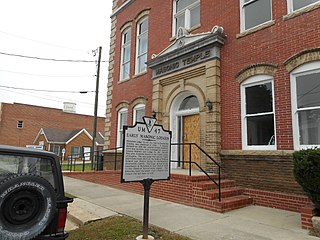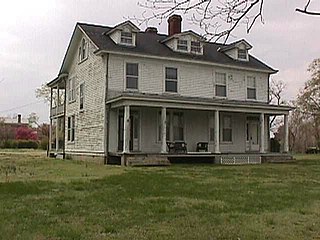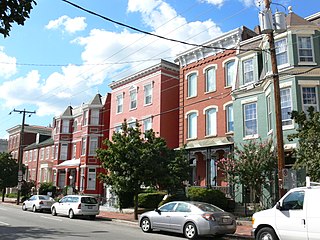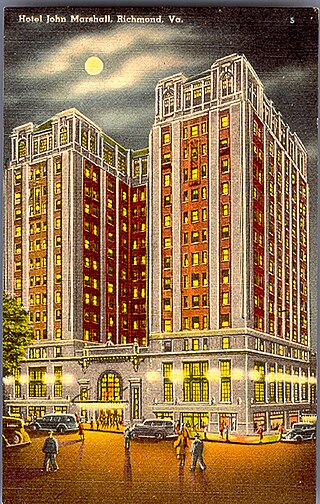
Markham is a small, unincorporated community in Fauquier County, Virginia, along State Route 55 and off Interstate 66. It is home to the Naked Mountain Vineyard, its own post office, and ZIP Code of 22643. The former Manassas Gap Railway runs through the community.

The Court House Hill–Downtown Historic District is a national historic district located in Lynchburg, Virginia. The area is situated on a promontory overlooking the Lower Basin Historic District on the south bank of the James River. The approximately 50-acre (200,000 m2) district is composed of relatively intact city blocks of religious, commercial, residential, and governmental buildings and structures ranging in date from the early 19th century to the mid-20th century. Buildings in the district represent a variety of styles from the different periods, including the Federal, Greek Revival, Gothic Revival, Italianate, Queen Anne, Neoclassical, Italian Renaissance, Spanish Eclectic, Craftsman, and Art Deco styles.

The Arlington Forest Historic District is a national historic district located at Arlington County, Virginia. It contains 810 contributing buildings and 3 contributing sites in a subdivision in South Arlington and two sites in North Arlington. It was developed in four stages between 1939 and 1948, known as Southside, Northside, Greenbrier, and Broyhill's Addition. In the first phase, from 1939 to 1946, Meadowbrook, the builder, collaborated with locally prominent architect Robert O. Scholz to design the modest two-story brick homes with minimal Colonial Revival detailing. The district is characterized by orderly rows of detached two-story, single family dwellings with minimal Colonial Revival style decorative detailing. It is representative of a mid-20th century planned mixed use community in Arlington County.

Catlett Historic District is a national historic district located at Catlett, Fauquier County, Virginia. It encompasses 119 contributing buildings, 2 contributing sites, and 11 contributing structures in the rural village of Catlett. It contains a collection of buildings that represent the town during the late 19th and early-to-mid 20th centuries. Notable buildings include Prospect Acres, Edmonds Place, Trenis House, the Gothic Revival style Trinity Church (1872), the former Ensor's Store, Leidy Wilson's Store, and the Wilson Farms Meat Company.

Delaplane Historic District is a national historic district located at Delaplane, Fauquier County, Virginia.

Hume Historic District is a national historic district located at Hume, Fauquier County, Virginia. It encompasses 59 contributing buildings in the rural village of Hume. The majority of the buildings in the district are vernacular in nature and are late-19th- to early- 20th-century frame dwellings of the side-passage and I-house form. It also contains three commercial buildings, a church, two schools, and a former tavern. Notable buildings include Barbee's Tavern, "The Dell," the parsonage for Leeds Church, former Captain Marshall's Store, the African-American Hume School, the former Hume Methodist Church, and the Hume Baptist Church (1921).

Markham Historic District is a national historic district located at Markham, Fauquier County, Virginia. It encompasses 44 contributing buildings and 4 contributing sites in the rural villages of Farrowsville and Markham. The majority of resources in the district were constructed in the mid- and late 19th century and include multiple dwellings, a hotel, as well as commercial buildings, and a train station. The district also contains early-20th-century dwellings. Notable buildings include Mountain View, Wolf's Crag, Rosebank, Markham School (1918), the 1819 stone Upper Goose Creek Church, and the former Markham Freight Station.

Marshall Historic District is a national historic district located at Marshall, Fauquier County, Virginia. It encompasses 314 contributing buildings and 3 contributing sites in the rural village of Marshall. The district represents a collection of historic buildings with a wide range of building types and architectural styles that date from the end of the 18th century to the mid-20th century. Notable buildings include the Fauquier Heritage and Preservation Foundation building, hosteller's house for Rector's Ordinary, a store and Confederate post office, the Elgin House, former Marshall Pharmacy, the Foley Building, the Gothic Revival style Trinity Episcopal Church (1849), Salem Baptist Church (1929), Marshall United Methodist Church (1899), and the Marshall Ford Company (1916), reputed to be the oldest building built as a Ford dealership in the United States that is still functioning as such.

New Baltimore Historic District is a national historic district located at New Baltimore, Fauquier County, Virginia. It encompasses 55 contributing buildings and 1 contributing structure in the rural village of New Baltimore. The majority of buildings in the district are dwellings, ranging in date from the 1820s to the mid-20th centuries. Notable buildings include the Federal style James Hampton's Tavern, Eastview, and the New Baltimore School (1915). The contributing structure is a one-lane bridge.

The Hollow is an historic property and dwelling located near Markham, Fauquier County, Virginia, U.S. A part of the John Marshall's Leeds Manor Rural Historic District, it was the boyhood home of Chief Justice John Marshall, and includes the second-oldest dated home in the county. Both the property and the district are listed in the Virginia Landmarks Register (2003) and National Register of Historic Places (2004).

Powhatan Rural Historic District, formerly "Powhatan Hill Plantation" and before that "Hopyard Plantation", is a national historic district located near King George, King George County, Virginia. It encompasses 15 contributing buildings, 1 contributing site, and 3 contributing structures in a rural area near King George. The district represents a significant reassemblage of the land holdings of Edward Thornton Tayloe, a member of the U.S. diplomatic service under Joel Roberts Poinsett, in the mid-19th century and one of Virginia's most affluent planters of that era; who inherited it from his father John Tayloe III, who built The Octagon House in Washington DC, and it was known then as 'Hopyard,' he inherited it from his father John Tayloe II who built the grand colonial estate Mount Airy. It contains three distinct historic residential farm clusters as well as two post-1950 stable complexes and several other auxiliary residential and agricultural buildings. The main house, known as Powhatan, is sited prominently on a ridge overlooking the Rappahannock River valley.

North Fork Valley Rural Historic District is a national historic district located near Blacksburg, Montgomery County, Virginia. The district encompasses 125 contributing buildings, 5 contributing sites, and 18 contributing structures. It consists of a significant rural landscape and an important collection of domestic and agricultural buildings, reflecting important agricultural practices in the region from 1745–1940. It includes domestic and agricultural buildings, a historic archaeological site, as well as an early-20th century school, two late-19th century churches, and five mid- to late-19th century industrial resources including three standing mills, a tanyard site, and a brick kiln site.

Buffalo Forge, also known as the Forge Complex, is a historic iron forge complex and national historic district located near Glasgow, Rockbridge County, Virginia. The district encompasses 11 contributing buildings, 1 contributing site, and 3 contributing structures. The manor house is known as Mount Pleasant and was built in two sections of similar stone construction. The earlier section dates to about 1819, and the wing was added about 1830. A frame wing was added in the late-19th century and a kitchen wing in the early-20th century. The district also includes the contributing kitchen, two slave quarters, garage, spring house / dairy, stone cabin (pre-1865), shed (pre-1900), stables / barn (pre-1865), corn crib (pre-1920), hen house (pre-1920), and the ruins of the merchant mill and mill race. Iron production at Buffalo Forge ceased in the fall of 1868.

The Marshall–Rucker–Smith House is a historic home located at Charlottesville, Virginia. It was built for J. William and Carrie Marshall in 1894 by William T. Vandegrift, the grandfather of General Alexander Archer Vandegrift, and is a two-story, nearly square, Queen Anne style brick dwelling. It has a three-story octagonal corner tower, a prominent front gable projection of the slate-shingled hip roof, a two-story rear wing, and multiple one-story porches. A two-story solarium and library wing were added by its second owner, William J. Rucker in about 1930. Also on the property is a contributing swimming pool which is now used as a members-only neighborhood pool. In the mid-20th century, after the house had been made into a rooming house, future Supreme Court Justice Sandra Day O'Connor numbered among its residents while her husband was attending the Judge Advocate General School at the University of Virginia School of Law.

Hicksford–Emporia Historic District, also known as Emporia, is a national historic district located at Emporia, Virginia. The district includes 36 contributing buildings and 2 contributing objects in the Hicksford section of Emporia. In 1848, Hicksford was a stop on the Petersburg Railroad. In 1887, the neighboring towns of Hicksford and Belfield merged to form the town of Emporia. The district generally consists of late 19th century or early 20th century, when Hicksford–Emporia began to evolve from a small agricultural outpost to a large commercial and governmental center. Located at the heart of the district is the separately listed Greensville County Courthouse Complex. Other notable buildings include the Citizen's National Bank, the Widow's Son's Masonic Lodge (1905), First Presbyterian Church (1907-1908), Emporia Elementary School, Emporia Armory (mid-1930s), Greensville County Auditorium (1934), and Emporia Post Office (1938). The Old Merchants and Farmers Bank Building is also separately listed.

City Point Historic District is a national historic district located at Hopewell, Virginia. The district encompasses 85 contributing buildings and 3 contributing sites at the tip of a peninsula at the confluence of the Appomattox River and James River. The district primarily includes one- and two-story, wood-frame single-family dwellings dated to the 19th century. Notable buildings include St. John's Episcopal Church (1840), Civil War Catholic Chapel (1865), the Cocke House, Miami Lodge (1912), Cook House, St. John's Rectory, and Christopher Proctor House. Located in the district and separately listed is Appomattox Manor.

The Block 0-100 East Franklin Street Historic District is a national historic district located at Richmond, Virginia. It is located west of downtown. The district encompasses 21 contributing buildings built between about 1840 and 1920. The district is characterized by numerous mid- to late-19th century brick town houses in a variety of popular 19th-century architectural styles including Queen Anne, Italianate, and Greek Revival.

The Grace Street Commercial Historic District is a national historic district located in Richmond, Virginia. The district encompasses 93 contributing buildings located in downtown Richmond. The buildings reflect the core of the city's early 20th-century retail development and the remnants of a 19th-century residential neighborhood. The buildings are in a variety of popular 19th-century and early 20th-century architectural styles, including Classical Revival, Mission Revival, International Style, and Colonial Revival. Notable buildings include the Administration and Equipment Building for the Chesapeake & Potomac Telephone Company (1929), Thalhimer's Department Store, Atlantic Life Building (1950-1959), Miller & Rhoads Department Store, Berry-Burk Building, former W. W. Foster Studios (1927), Bank of Virginia (1949), Investment Realty Company building (1930), W.T. Grant Store (1939), Hotel John Marshall (1927), Franklin Federal Savings and Loan building (1954), and the Tompkins House (1820). Located in the district and separately listed are the Loew's Theatre, Centenary United Methodist Church, Joseph P. Winston House, Central National Bank, and National Theater.

The Brookland Park Historic District is a national historic district located at Richmond, Virginia. The district encompasses 1,157 contributing buildings located north of downtown Richmond and Barton Heights.

Wharf Area Historic District is a national historic district located at Staunton, Virginia. The district encompasses 22 contributing buildings and 4 contributing structures. It is a warehouse and commercial district characterized by rows of late-19th century and early-20th century storefronts and an elongated plaza framed by small warehouses. The buildings are characteristically two- and three-story, brick structures in a variety of popular architectural styles including Greek Revival, Federal, and Queen Anne. Notable buildings and structures include the Railroad Water Tower, American Hotel, John Burns Building (1874), Erskine Building (1904), and Chesapeake and Ohio Railroad Station (1902).


























